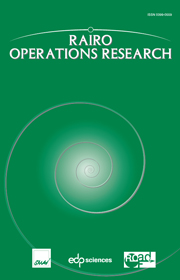Crossref Citations
This article has been cited by the following publications. This list is generated based on data provided by
Crossref.
Bodlaender, Hans L.
Grigoriev, Alexander
and
Koster, Arie M. C. A.
2005.
Algorithms – ESA 2005.
Vol. 3669,
Issue. ,
p.
391.
Bodlaender, Hans L.
2005.
SOFSEM 2005: Theory and Practice of Computer Science.
Vol. 3381,
Issue. ,
p.
1.
Koster, Arie M. C. A.
Wolle, Thomas
and
Bodlaender, Hans L.
2005.
Experimental and Efficient Algorithms.
Vol. 3503,
Issue. ,
p.
101.
Bachoore, Emgad H.
and
Bodlaender, Hans L.
2006.
Algorithmic Aspects in Information and Management.
Vol. 4041,
Issue. ,
p.
255.
Bodlaender, Hans L.
Fomin, Fedor V.
Koster, Arie M. C. A.
Kratsch, Dieter
and
Thilikos, Dimitrios M.
2006.
Algorithms – ESA 2006.
Vol. 4168,
Issue. ,
p.
672.
Bodlaender, Hans L.
2006.
Graph-Theoretic Concepts in Computer Science.
Vol. 4271,
Issue. ,
p.
1.
Shcherbina, O. A.
2007.
Tree decomposition and discrete optimization problems: A survey.
Cybernetics and Systems Analysis,
Vol. 43,
Issue. 4,
p.
549.
Musliu, Nysret
2007.
Evolutionary Computation in Combinatorial Optimization.
Vol. 4446,
Issue. ,
p.
130.
Lucena, Brian
2007.
Achievable sets, brambles, and sparse treewidth obstructions.
Discrete Applied Mathematics,
Vol. 155,
Issue. 8,
p.
1055.
Bodlaender, Hans L.
2007.
Structural Information and Communication Complexity.
Vol. 4474,
Issue. ,
p.
11.
Bodlaender, Hans L.
and
Koster, Arie M.C.A.
2007.
On the maximum cardinality search lower bound for treewidth.
Discrete Applied Mathematics,
Vol. 155,
Issue. 11,
p.
1348.
Bodlaender, Hans L.
Grigoriev, Alexander
and
Koster, Arie M. C. A.
2008.
Treewidth Lower Bounds with Brambles.
Algorithmica,
Vol. 51,
Issue. 1,
p.
81.
Borie, Richard B.
Parker, R. Gary
and
Tovey, Craig A.
2009.
Solving problems on recursively constructed graphs.
ACM Computing Surveys,
Vol. 41,
Issue. 1,
p.
1.
Bodlaender, Hans L.
and
Koster, Arie M.C.A.
2010.
Treewidth computations I. Upper bounds.
Information and Computation,
Vol. 208,
Issue. 3,
p.
259.
Hammerl, Thomas
and
Musliu, Nysret
2010.
Evolutionary Computation in Combinatorial Optimization.
Vol. 6022,
Issue. ,
p.
95.
Bodlaender, Hans L.
Jansen, Bart M. P.
and
Kratsch, Stefan
2011.
Automata, Languages and Programming.
Vol. 6755,
Issue. ,
p.
437.
Overwijk, Arnold
Penninkx, Eelko
and
Bodlaender, Hans L.
2011.
SOFSEM 2011: Theory and Practice of Computer Science.
Vol. 6543,
Issue. ,
p.
444.
Bodlaender, Hans L.
Fomin, Fedor V.
Koster, Arie M. C. A.
Kratsch, Dieter
and
Thilikos, Dimitrios M.
2012.
On exact algorithms for treewidth.
ACM Transactions on Algorithms,
Vol. 9,
Issue. 1,
p.
1.
Bodlaender, Hans L.
Fomin, Fedor V.
Koster, Arie M. C. A.
Kratsch, Dieter
and
Thilikos, Dimitrios M.
2012.
A Note on Exact Algorithms for Vertex Ordering Problems on Graphs.
Theory of Computing Systems,
Vol. 50,
Issue. 3,
p.
420.
Bodlaender, Hans L.
Jansen, Bart M. P.
and
Kratsch, Stefan
2013.
Preprocessing for Treewidth: A Combinatorial Analysis through Kernelization.
SIAM Journal on Discrete Mathematics,
Vol. 27,
Issue. 4,
p.
2108.

